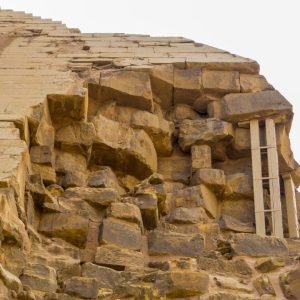

Home » Weekly Blog » Unraveling the Enigma: The Bent Pyramid of Egypt
The vast expanse of the Egyptian desert hides within its sands not just tales of ancient civilizations but also architectural wonders that continue to baffle historians and archaeologists. Among these enigmatic structures stands the Bent Pyramid, a testament to the complexities of ancient Egyptian engineering and the mysteries that shroud its construction. Rising from the desert like a giant sentinel, the Bent Pyramid is a unique and captivating structure that beckons us to delve into the rich tapestry of Egypt’s past.
The Bent Pyramid, located approximately 40 kilometers south of Cairo, is a part of the Dahshur Necropolis and is attributed to Pharaoh Sneferu, a prominent ruler of the Fourth Dynasty during the Old Kingdom. While Egypt is home to numerous pyramids, each with its own distinct characteristics, the Bent Pyramid stands out for its peculiar shape—a departure from the more conventional, straight-sided pyramids that dominate the landscape. This departure raises intriguing questions about the motivations and challenges faced by the ancient Egyptians during its construction.
As we embark on a journey to unravel the secrets of the Bent Pyramid, we find ourselves confronted with a myriad of questions. Why does the pyramid have a bent appearance, and what engineering challenges led to this deviation from the norm? What cultural and religious significance does the Bent Pyramid hold in the context of ancient Egyptian beliefs? How has modern technology contributed to our understanding of this ancient marvel? In this exploration, we will navigate through the historical context, delve into the architectural intricacies, and ponder the unsolved mysteries that surround the Bent Pyramid. Join us as we unravel the enigma and seek to understand the Bent Pyramid’s place in the grand narrative of ancient Egypt.

To comprehend the significance of the Bent Pyramid, it is imperative to delve into the broader context of pyramid construction during the Old Kingdom. The Old Kingdom, often referred to as the Age of the Pyramids, witnessed an unprecedented surge in monumental architecture. The construction of pyramids was not merely a testament to the might of pharaohs but also an embodiment of their divine authority and a conduit for their journey into the afterlife.
The construction of pyramids during this period followed a well-established architectural tradition, with the Step Pyramid of Djoser at Saqqara being a precursor. As pharaohs sought to immortalize their reigns and secure their places in the divine realm, the pyramid became the quintessential structure embodying these aspirations. The Bent Pyramid, emerging from this historical backdrop, reflects both the mastery and experimentation characteristic of the era.
The Bent Pyramid is attributed to Pharaoh Sneferu, the father of Khufu, the builder of the Great Pyramid of Giza. Sneferu, known for his ambitious building projects, ruled during a time of expansion and prosperity. His reign marked a pivotal era where the techniques of pyramid construction were honed and perfected.
Sneferu’s architectural legacy is not confined to the Bent Pyramid alone. In addition to this unique structure, he is also associated with the construction of the Red Pyramid, located nearby in Dahshur. The Bent Pyramid, however, stands out as an experimental venture, providing a glimpse into the challenges and innovations that accompanied the quest for monumental immortality.
The Bent Pyramid’s deviation from the conventional pyramid shape poses questions about its purpose and the circumstances that led to its distinctive design. Some scholars propose that the initial angle of the pyramid was altered during construction due to structural concerns or engineering challenges, while others suggest a symbolic or religious motive behind the bend.
Understanding the purpose of the Bent Pyramid requires a nuanced exploration of Sneferu’s motivations and the socio-cultural milieu of ancient Egypt. Was the Bent Pyramid an ambitious project that pushed the boundaries of engineering capabilities, or does its unique shape hold deeper metaphysical meanings? By unraveling the historical context, we can begin to decipher the layers of significance embedded in this ancient architectural marvel.
The Bent Pyramid’s enigmatic design has spurred a plethora of theories and speculations among scholars, each attempting to unravel the mysteries concealed within its limestone walls. Some propose that the alteration in slope was a pragmatic response to structural challenges, aiming to prevent the collapse experienced in earlier pyramid attempts. Others suggest a symbolic interpretation, linking the bent shape to cosmological or religious beliefs held by the ancient Egyptians.
Exploring these theories provides a fascinating journey into the minds of the architects and pharaohs of the Old Kingdom. Did the builders intentionally deviate from convention to convey a deeper message, or were they driven by practical considerations? Theories surrounding the Bent Pyramid continue to evolve as new archaeological evidence emerges, challenging preconceptions and inspiring a renewed quest for understanding the motivations behind this unique architectural experiment.

The construction of the Bent Pyramid was not without its share of challenges, and unraveling the mysteries behind its unique design requires a close examination of the structural issues encountered by the ancient builders. Theories abound regarding the reasons for the pyramid’s bent appearance, and structural considerations often take center stage in these discussions.
One prevailing hypothesis suggests that the original, steeper angle of the pyramid posed stability issues, leading to the decision to alter the slope midway through construction. The builders, faced with the potential risk of collapse, adapted their approach to ensure the structural integrity of the monument. Analyzing the geological and engineering aspects of the construction process provides valuable insights into the decision-making of the ancient architects and the solutions they devised to overcome these challenges.
The alteration in the pyramid’s angle raises intriguing questions about the motivations behind this mid-construction adjustment. Several theories have been put forth to explain why the builders opted for a bent shape, deviating from the conventional pyramid design.
One hypothesis suggests that the change in angle was a pragmatic response to the limitations of the construction materials or techniques available at the time. Another theory proposes that the alteration may have been a deliberate choice to align the pyramid with astronomical or religious significance. As we explore these theories, we gain a deeper understanding of the complex decision-making processes that characterized ancient Egyptian architecture.
While the Bent Pyramid’s bent shape may initially seem like an anomaly, it also represents a testament to the innovative spirit of the ancient Egyptian builders. The challenges faced during its construction likely spurred the development of new engineering solutions and construction techniques.
Investigating the engineering innovations associated with the Bent Pyramid offers a window into the technological prowess of the Old Kingdom. What lessons were learned from the construction of the Bent Pyramid, and how did these lessons influence subsequent pyramid projects in Egypt? Understanding the engineering feats achieved by the ancient builders allows us to appreciate the Bent Pyramid not only as an architectural marvel but also as a crucible of knowledge that shaped the future of monumental construction in ancient Egypt.
The Bent Pyramid, like its straight-sided counterparts, is deeply intertwined with the religious and spiritual beliefs of ancient Egypt. Pyramid construction was not merely a display of architectural prowess; it held profound significance in the religious cosmology of the time. The pyramid was considered a bridge between the earthly realm and the afterlife, a conduit through which pharaohs could ascend to join the gods.
Exploring the religious context surrounding the Bent Pyramid involves unraveling the symbolism and rituals associated with its construction. Did the bent shape carry specific religious connotations, or was it an experiment born out of the pharaoh’s desire to create a unique monument? Examining the religious underpinnings provides a crucial lens through which we can interpret the Bent Pyramid’s role in ancient Egyptian culture.
As a product of the Old Kingdom, the Bent Pyramid reflects the prevailing religious beliefs and practices of the time. The pyramid, with its intricate passages and burial chambers, was a vessel for the pharaoh’s journey to the afterlife. Understanding the connection between the Bent Pyramid and ancient Egyptian beliefs requires a nuanced exploration of the religious symbolism embedded in its design.
Some scholars posit that the bent shape may have held symbolic significance, representing a transitional phase in the pharaoh’s journey from the earthly realm to the divine. Others suggest alignments with celestial bodies or mythological narratives that imbued the Bent Pyramid with a deeper, metaphysical meaning. By delving into the religious tapestry of ancient Egypt, we gain a richer understanding of why the Bent Pyramid deviates from the conventional pyramid form.
The construction of a pyramid was not a solitary act but a communal endeavor deeply rooted in rituals and ceremonies. The Bent Pyramid, with its unique design, likely witnessed a series of ceremonies that held both practical and symbolic significance. Examining the rituals associated with the Bent Pyramid provides a glimpse into the societal and religious dynamics of ancient Egypt during the Old Kingdom.
Did the builders perform specific ceremonies during the alteration of the pyramid’s angle? Were there rituals marking the completion of different construction phases? Unraveling the ceremonial aspects of the Bent Pyramid enriches our understanding of the cultural practices that accompanied monumental construction in ancient Egypt and underscores the interconnectedness of architecture, religion, and society in the shaping of the Egyptian worldview.
Modern archaeological endeavors near the Bent Pyramid have unearthed a trove of valuable information, shedding light on the complexities of ancient Egyptian life and culture. Excavations in the vicinity of the pyramid have revealed artifacts, inscriptions, and evidence of surrounding structures, providing valuable context for understanding the broader archaeological landscape.
Archaeologists have meticulously studied the area, uncovering clues about the daily lives of the people involved in the construction of the Bent Pyramid. The discoveries offer glimpses into the tools, techniques, and materials employed during the Old Kingdom, fostering a more nuanced comprehension of the socio-economic and technological aspects of ancient Egyptian civilization.
Preserving ancient structures like the Bent Pyramid is a delicate balancing act between maintaining the integrity of the monument and allowing for continued exploration. Conservation efforts have been instrumental in safeguarding the Bent Pyramid from natural elements, erosion, and human impact.
Various conservation projects have focused on stabilizing the structure, addressing structural vulnerabilities, and implementing measures to mitigate environmental threats. The aim is not only to ensure the physical longevity of the pyramid but also to create an environment conducive to ongoing research and exploration.
Advancements in technology have revolutionized the study of ancient monuments, providing archaeologists with powerful tools to unravel the mysteries of structures like the Bent Pyramid. Non-invasive techniques such as ground-penetrating radar, LiDAR, and 3D scanning have allowed researchers to peer beneath the surface without causing harm to the monument.
The application of cutting-edge technology has enabled archaeologists to create detailed digital models of the Bent Pyramid, offering insights into its internal structure and construction processes. This marriage of tradition and technology ensures that the exploration of ancient sites continues to evolve, fostering a deeper understanding of the Bent Pyramid and its place in the broader narrative of ancient Egyptian history.
As we stand on the intersection of the ancient and the modern, the marriage of archaeological exploration and technological innovation holds the promise of unveiling new facets of the Bent Pyramid’s story, propelling our understanding of this enigmatic structure to greater heights.
Despite centuries of study and exploration, the Bent Pyramid remains a subject of ongoing debates and scholarly controversies. Questions surrounding its bent shape, altered angle, and the motivations behind its unique design continue to fuel discussions among historians, archaeologists, and Egyptologists.
One persistent debate centers on the pragmatic reasons for the alteration in the pyramid’s angle. While some argue that structural concerns prompted the change to avoid potential collapse, others propose that symbolic or religious considerations played a more significant role. The lack of definitive evidence has led to divergent opinions, highlighting the complexity of interpreting the motivations of ancient builders.
The Bent Pyramid, with all its allure and historical significance, leaves us with a multitude of unanswered questions. What was the precise purpose behind the pyramid’s unconventional design? Did Sneferu envision the bent shape as a departure from tradition, or did unforeseen challenges force a mid-construction alteration?
While progress has been made in understanding the Bent Pyramid, gaps in knowledge persist. Future research holds the promise of unveiling more about the construction techniques, cultural context, and societal implications associated with this unique monument. The quest for answers continues, inviting the next generation of researchers to explore, question, and challenge existing theories.
Beyond its individual mysteries, the Bent Pyramid contributes significantly to broader archaeological discussions about the evolution of pyramid construction, engineering practices, and the cultural landscape of ancient Egypt. Its unique design challenges preconceptions about the uniformity of pyramid structures and underscores the dynamic nature of architectural experimentation during the Old Kingdom.
The Bent Pyramid’s significance extends beyond its physical form; it serves as a symbolic gateway to understanding the intellectual and spiritual pursuits of the ancient Egyptians. As researchers delve into its mysteries, the Bent Pyramid becomes a focal point for reevaluating assumptions about the motivations of ancient builders, the role of experimentation in architecture, and the interconnectedness of religious beliefs and monumental construction.
In conclusion, the Bent Pyramid stands not only as a testament to the ingenuity of the ancient Egyptians but also as an enduring enigma that beckons future generations to unravel its secrets. The ongoing debates, unanswered questions, and the broader significance of the Bent Pyramid inspire a continued exploration of the past, ensuring that this remarkable structure continues to captivate and challenge our understanding of ancient Egypt.
In this exploration of the Bent Pyramid, we have journeyed through the annals of ancient Egyptian history, unraveled the architectural intricacies of this enigmatic structure, and contemplated the unresolved mysteries that shroud its construction. From its unique design to the ongoing debates surrounding its purpose, the Bent Pyramid stands as a captivating testament to the complexity of ancient Egyptian civilization.
We began by delving into the historical context, understanding the Old Kingdom’s penchant for monumental architecture and the reign of Pharaoh Sneferu, a key figure in the development of pyramid construction. The Bent Pyramid, with its distinctive shape, emerged as an experimental venture that challenged conventional norms and pushed the boundaries of ancient engineering.
The architectural features of the Bent Pyramid, from its bent appearance to the altered angles, sparked discussions on the challenges faced during its construction. Structural issues, theories on the mid-construction alteration, and the engineering innovations associated with the pyramid provided insights into the complexities that defined the building process.
Our exploration extended to the religious and cultural significance of the Bent Pyramid within the context of ancient Egypt. We uncovered the deep connections between pyramid construction and religious beliefs, contemplating the rituals and ceremonies that may have accompanied the building of this monumental structure.
As we conclude our journey through the mysteries of the Bent Pyramid, it is evident that this ancient marvel continues to beckon researchers and enthusiasts alike. The ongoing debates, unanswered questions, and the evolving role of technology in archaeological exploration underscore the dynamic nature of our understanding of the past.
The Bent Pyramid serves as a reminder that the study of ancient Egypt is a dynamic and ever-unfolding process. New discoveries, technologies, and perspectives will likely reshape our understanding of this extraordinary civilization. As we stand at the intersection of past and present, the Bent Pyramid invites us to embark on a continued journey of exploration and research, ensuring that its secrets remain a source of inspiration and contemplation for generations to come.
Sign up to hear about our upcoming adventures, monthly newsletter, exclusive offers, and more!
Required*
Not Ready to book?
Get regular updates on upcoming tour and special promotions.







Sign up for our Mailing List to get updates on our current offerings.